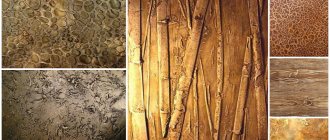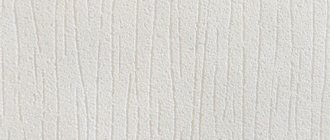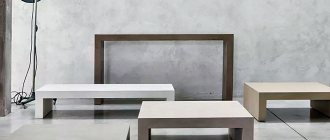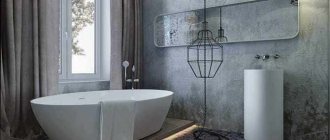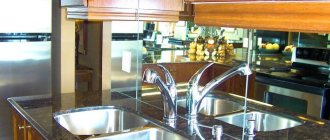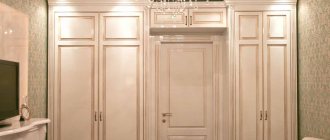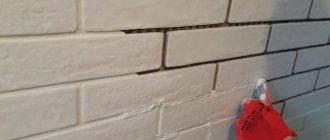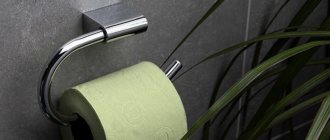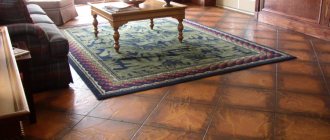The design of the facade is important, because the overall appearance of the house depends on the quality of the work performed and the chosen design. Painting plaster involves the use of a wide palette of shades. Depending on the owner’s requests, it is possible to use basic shades or provide a combination of them.
The main requirement is that the color type of the cladding should look harmonious with the roof and surrounding objects. The color of plaster is not limited only to basic colors, such as gray, brown, blue, white - many other shades are available for sale that can create an individual image of the building.
The exterior of the house is usually designed in accordance with the taste preferences of the owner, so the main emphasis is on the initially chosen style. Decorative plaster is distinguished by its individual texture, so before choosing a color scheme you should decide on its format. Facade decor is presented in the following directions:
- The effect of old walls . Most often, the walls are painted with gold, silver or copper paint, while the top is left white and untreated. This design is used in antique, modern style.
- Craquelure . The presence of decorative cracks visually creates an attractive composition that will look stylish in pastel and light colors.
- Smooth . The most traditional type, which has a discreet format. The owner can choose any color, depending on his preferences.
- Rough with an abstract pattern . The inside should be several tones darker to create visual volume. The outer side is artificially erased to lighten it.
- Pearlescent silk effect . This style predominates in the interior of rooms, but it can also be found in the external cladding of cottages. The delicate texture will look best with fresh and pastel shades.
- With deep relief . The surface has a chaotic structure. Decorating such a wall is an art, because you need to use light and warm shades together. It is best to choose natural palettes.
- Fur coat . Today you can find the most exotic shades - from orange to lilac.
- Fine mineral chips . This format can not be painted at all, but coated with a colorless varnish texture for protection and visual shine.
What color can the decorative plaster on the facade of your house be? Selection by style
You might think that painting plaster is a simple choice that does not require a special approach, because “pick the color you like and be happy with the result.” But it is not so! The palette directly depends on the chosen style in which a residential building or other institution is built. According to experts, the cladding of the facade of a house is divided into the following categories:
- Provence . The predominance of light pink, blue, milky, as well as lavender and mint. The main emphasis is on tenderness and freshness, which is inherent in the French style in home decoration.
- High-tech - the use of black, white, metallic, and gray. The ultra-modern style features a discreet and laconic design. It is recommended to select even and smooth plaster.
- Baroque - absolutely all pastel and warm colors, especially gold. The main task is to emphasize the luxury that the Baroque style is filled with.
- Eco is the color of lawn, greenery, swamp. Naturalness is welcome and no bright or unnatural shades.
- Classic - white color is a mandatory requirement, since in classical architecture the basis is plaster modeling. Elements of the walls can be painted white, and the rest - gray, brick, blue, sand, yellow.
- Modern - it is best to choose brown, green, blue shades.
- Minimalism - a win-win option would be white and black colors, as well as their shades. You can complement the composition with pastel colors.
- Futurism - designers recommend choosing lemon, white, black, ultramarine shades.
- Country - the presence of brown, sand, yellowish will ideally emphasize the rural theme.
- Loft - freedom in creativity is available here. Using orange, red, blue, green looks most successful.
There are also other stylistic trends, but these are the main ones from which you should start. The selected shades will best highlight the architecture of the object and look harmonious with the surrounding space.
Popular plaster models
PARADE DECO S90
A suitable option for those who want to give the room an unusual look. The plaster has the effect of a large fur coat. The product does not require any preliminary mixing or dilution with liquid, since the mixture is ready-made. Thanks to the special components in the composition, a good hydrophobic coating is provided, with good vapor permeability. No atmospheric phenomena will damage the outer layer.
The average cost is 2,220 rubles.
PARADE DECO S90
Advantages:
- Has good adhesion;
- Easy to clean;
- There is no smell;
- Easy application;
- Best performance characteristics.
Flaws:
- Not detected.
ALPA DECOCRYL
An environmentally friendly option based on cellulose filler that will last for decades and does not require complex maintenance. Dust will not stick to the surface, and any dirt can be easily removed. The coating is breathable, so mold and mildew will not develop. Drying occurs after 24-36 hours, it all depends on the conditions where the work is being done. Product consumption is minimal and amounts to only 1 kilogram per square meter.
The average cost is 1,800 rubles.
ALPA DECOCRYL
Advantages:
- Easy to update;
- There are several decorative effects;
- Masks various flaws;
- High resistance to low temperatures;
- Attractive matte surface.
Flaws:
- Not found.
Weber.pas akrylat 1.5 mm fur coat 100A
A reliable option that is suitable for application to various walls. The color range is quite wide, as the product can be tinted without any problems. The flammability group is G1, which is a good indicator and guarantees safety. Operating temperature -50…+70 degrees. Guarantees high resistance to mechanical damage and does not deteriorate due to high humidity.
The average price is 1,320 rubles per 10 kg.
Weber.pas akrylat 1.5 mm fur coat 100A
Advantages:
- Vapor permeability;
- Durability;
- Frost resistance;
- Hydrophobicity;
- Does not deteriorate from exhaust gases;
- Efficiency;
- Easy to apply.
Flaws:
- Not found.
Sikkens Alpha Tacto
A decorative mixture that is used only for interior renovation work. The minimum application temperature is 5 degrees. The peculiarity of the product is fast drying - 12 hours. In addition, the material is tinted quite well. Application is carried out manually. The mixture is ready-made, which reduces time costs.
Sold at a price: from 8,720 rubles.
Sikkens Alpha Tacto
Advantages:
- Good strength;
- Long service life;
- Reliability;
- Nice performance;
- Easy application;
- Dries quickly.
Flaws:
- Not detected.
Color palette for painting exterior decorative plaster using the example of Ceresit (Ceresit)
How to decorate the facade of a house if you don’t know what color to choose? In order not to get confused in hundreds of shades from light ash to mustard, you should combine all the colors into groups according to associations. For your convenience, samples are attached to each category that can be used for further wall decoration:
Sand . The color of the plaster ranges from light gray to orange. Natural sandy shades also include dull yellow, pinkish, and peach.
Water . In this category you can find blue, blue, aqua, grayish blue, azure. This is the most limited palette, but it is often chosen for the design of modern houses.
Earth . The main emphasis is on shades of red, brown, purple. Gray is also present in this group. Shades of clay, rocks, sunset color - these formats will visually highlight the architecture of the house.
Forest . The aesthetics of green color is expressed in many interpretations. From light green and light green to mint, ultramarine, pale green, marsh. Gray also comes in several formats as it forms the basis of every color category.
BEIGE COLOR DECORATIVE PLASTER
Painting plaster in beige color, according to many, looks rather boring and monotonous. But this is not at all true, because in addition to the standard cream, this palette contains the following shades:
- Grey-beige. The predominance of gray and pastel in the facade design looks win-win, because such a composition combines classics and a modern approach.
- Neutral beige. The most traditional choice for those who love beige in all its forms.
- Mauve Beige – Adding a touch of mauve adds a rich floral tone.
- Brown-beige - looks very natural and calm against the background of other bright undertones.
- Pink beige is a compromise between pink and pastel tones.
- Green-beige - looks very natural against the background of the surrounding landscapes.
- Yellow-beige - sandy-earth tone predominates.
- Peachy beige - delicate and moderately rich.
- Orange-beige is bright, warm and rich.
Yellow color - what kind of plaster can be painted?
Yellow façade colors have always been associated with brightness, sun, southern regions and everything that looks cheerful.
Today, not only pure yellow, but also its dark and light shades are available for painting facades.
To create a new type of yellow, green and red are additionally built in, so the output colorists get is orange, gold, mustard, as well as dull yellow or maize, “dirty” yellow or khaki.
The predominance of the main shade over the secondary one allows you to create formats that are closer to pure yellow.
To prevent the decoration of the facade of the house from looking too bright, you should choose calmer shades such as saffron, mustard, old gold, which you can see in the photo.
Orange color - photo of decorative plaster colors
The orange color of the plaster represents warmth, so this format will definitely make the house more visible against the background of the surrounding space and visually pleasing.
In addition to the well-known colors of “pumpkin”, “orange” and “carrot”, there are also shades of mahogany, coral, peach, salmon, bronze, and terracotta.
Orange can be divided into categories:
- Basic. From “international orange” to tangerine. Saturation is more than 50%.
- Light. A barely noticeable shade of orange or its almost complete dissolution in white and pastel. Saturation about 20%.
- Dark. Very rich tones are closer to earth and wood, which are closer to brown.
Tools and equipment for work
Without a suitable tool, the surface cannot be decorated. Application technology requires the following arsenal:
- a set of spatulas, from narrowest to widest. In addition, you will need metal, rubber, rigid, flexible and comb products. They are needed to create the required texture;
- a spatula to create a wood effect, a squeegee that has notches on the blade;
- trowel;
- rubber rollers with a relief (pattern) applied to the canvas;
- brush with stiff bristles.
Additionally, some people use sponges, plastic bags, combs, etc.
As you can see, all work on creating a wood texture is performed with simple tools that are affordable and easy to buy. Secret: instead of a rubber structural roller, you can buy a regular one and wrap it with thread, tape, cellophane, wire and other available means. Thanks to such folds, a relief is formed that imitates the cut of natural wood. Another option is to form a pattern with your fingers using gloves.
In addition to this set, you need a primer, plaster, a roller and a brush, a broom, a container for mixing plaster, and a mixer.
PASTEL COLORS FOR PAINTING DECORATIVE PLASTER
The pastel colors of the facades are distinguished by a variety of calm shades. Each individual color is present in the pastel group, but in a more faded form. This category is divided into cold and warm tones, so the user can choose the direction of the future design.
Pastel colors should be chosen as a compromise between bright and calm. Green will emphasize the naturalness of the surrounding landscape, yellow and orange will fill the building with light and warmth, pink will give contrast and romanticism. As for blue and blue shades, they look fresh in all the proposed positions.
Purple color textured plaster
The purple color of the plaster is a contrast to the yellow shade. This choice emphasizes the artistry, calmness, and sensuality of its owner. A rich tone will balance the entire architecture of the building, due to the combination of warm, dark and bright shades in one.
The classic “representative” of purple is plum, which stands next to the blue palette. The lightest shade is considered to be heliotrope, associated with a natural floral theme. Often, purple color is used to highlight some part of the wall in combination with gray, white, and pastel.
Pink color decorative plaster walls
Despite its romanticism and sensuality, pink is rightfully considered a neutral shade in facade design. Painting the plaster pink will allow you to achieve a balanced saturation if the owner does not dare to use brighter colors. Choosing pink does not mean that the object will look like “Barbie’s house.”
This color scheme is skillfully combined with gray, white, black, pastel, which makes it universal in the arsenal of any colorist. The main thing is not to combine pink with reddish, lilac tones, otherwise the walls will lose their intended luster.
Green colors of houses - plaster
It is not for nothing that green is considered the color of nature, which has a beneficial effect on moral and psychological well-being. Greenery is visually perceived as calm and solitude with nature, so many designers recommend adding at least a green accent to the design of the facade.
The facade of the house in green is divided into positions:
- Malachite is a rich herbal.
- Green meadow - classic warm.
- Spring - a combination of mint and blue.
- Green and forest green are almost identical and the difference is one tone.
- You should also not confuse sea green and jade, as we can see in the photo - each of them is individual.
- The calm subsection of greens opens with apple and mint.
- As for olive, camouflage, khaki, asparagus, these colors are the result of the addition of gray and brown.
Gray color – gray decorative plaster
Painting plaster gray is a universal format if you are planning to decorate your home in a modern style. A color of this class combines calm, severity, brevity, and richness. The composition of gray may include blue, green, cyan, black, which to a certain extent change the saturation.
Gray is the anchor for any color, so you can't go wrong with it.
Blue color facade plaster
The blue color of the plaster symbolizes lightness and peace. In many cultures, the color of heaven is considered sacred and divine, which is why it can be found in church architecture.
To make the facade of the house look balanced, you can completely limit yourself to just one blue color. It looks complete on its own and does not require the addition of brighter colors. The exception is white and all its shades, since these two directions complement each other.
Pale cornflower blue, as well as “Niagara” and gray are very popular in coloring decorative plaster. These tones look calm, rich, and at the same time do not require lightening with secondary colors.
Blue color - cool colors for painting decorative plaster
Cladding the facade of a house with blue color is popular due to its conservatism, nobility, and fullness. This color emanates prudence and sincerity, therefore, in the exterior, such a palette acquires an aesthetically attractive meaning. Blue goes best with white, gray, and red, so the façade can be painted in several palettes.
This color category is distinguished by its rich variety. The most prominent “representatives” are:
- Sea wave and azure - the water theme is actively used in the style of facades.
- Sapphire and ultramarine are a combination of blue and violet.
- Denim - balanced blue and light blue.
It should be noted that the category of blue shades also includes all the main shades of blue. Therefore, for a broader vision, you should rely on this color map, which gives more freedom of choice.
Technology
In order for the paint to adhere well to existing painted plaster, the first step is to ensure the room temperature is +20°C. Temperatures that are too low or too high will have a negative effect on the work result.
To apply paint, you can use a long-nap roller or a spray bottle with a compressor. Experts recommend a roller. Because it distributes the paint more evenly over the wall surface. But they must work very quickly so that the drips do not have time to dry. It will be quite difficult to fix them.
And the main thing to remember is that in any case it is necessary to take into account all the nuances and be careful. Then the result will delight the eyes of the household. In addition, you should not skimp on the material, because if the paint is too cheap, it will be visible to the naked eye.
WHITE – WHITE DECORATIVE PLASTER
White façade decor is a choice towards laconicism, minimalism, light and openness. This is rightfully the most universal color that can be used in exterior styling.
The white color palette is not as neutral as it seems at first glance. Snow-white gradually turns into white-lilac, cloudy, white-blue, marshmallow, vanilla, as well as ice color and other rare shades.
The white facade looks harmonious with all dark and bright shades, making them more neutral and balanced. From the point of view of the combination of the facade and the roof on the roof, white will visually create freedom and a sense of space.
In almost all stylistic directions you can find white plaster. This image will add brightness and attractiveness in combination with the environment.
Acrylic
Plaster based on acrylic resin, which makes it plastic and able to repel water, and also improves adhesion. It is quite simple to work with, but before application it requires careful preparation of the surface, as well as its primer. It is available for sale in ready-made form, which is very convenient - you do not need to dilute the dry mixture.
DARK COLORS OF FACADE PLASTER
The exterior of the house in dark colors is a universal solution if you do not plan to experiment with color or use too light shades. For example, brown looks great with a red, blue, white, black roof. The same goes for other dark palettes. Each individual color has its own dark tones, which in almost 100% of cases look good against the background of the building. This is because calm and rich shades visually attract the eye and give a feeling of calm.
Brown colors of decorative bark beetle plaster
The color brown is associated with homeliness, warmth, nobility and stability. For this reason, many owners subconsciously choose brown as the basis for the future facade. In modern times, a wide variety of brown palettes are available for sale:
- Green-brown. The presence of a greenish tint allows you to apply color in areas where classic brown is not appropriate. For example, eco style and classic.
- Clay-brown. A subsection of earth tones that look very natural and blend well with the natural landscape.
- Walnut. A classic format that can be found in the style of country houses.
- Copper brown is a richer color than walnut. It is distinguished by the presence of a reddish tint.
- Red-brown. A rich, noble shade is an alternative to the fashionable color Marsala.
- Chocolate is an attractive color that is often associated with coffee.
- Cinnamon is the purest shade of brown, which is the standard.
- Chestnut - black-brown shade is characterized by increased saturation.
Coffee color – decorative plaster with brown flowers
Painting plaster coffee has a number of advantages:
- A great alternative between brown and light shade. Coffee is available in light and dark shades, which were created based on the coffee drink and its recipe. For example, coffee with added milk takes on a creamy chocolate hue, while pure black coffee turns dark brown.
- A façade of this format looks very self-sufficient and high-status. Shades of wood fill the design of the house with solidity, comfort, and security.
- A win-win solution in combination with a roof in all brown and dark shades.
Dark red color – decorative plaster of bright color
Do you love the color red, but don't want to decorate the façade with a more restrained design? Then you should pay attention to the dark red palette.
For true connoisseurs, designers recommend paying attention to the following shades:
- Bosa Nova. The calmest shade, close to brown. Woody notes evoke a feeling of stability and privacy, which is important for both interior and exterior decoration of a home.
- Hot Lava - bright, ardent, heated. The name speaks for itself. A façade in this style is popular in Scandinavian countries.
- Pompeii - often compared to cherry. It looks very juicy and attractive.
- Chilli. A rich cherry shade that will highlight the facade of the house against the background of the surrounding space.
- Red tango. Passionate, romantic, confident - these words can describe the color of tango, which originates from Spain.
- Rumba or Marsala. Noble, moderate, calm color, vaguely close to purple.
Dark green color is the classic color of plaster in the photo of facades
Decorating the façade of a house in dark green is predominantly found in the loft, minimalism, and Scandinavian style. Some may consider such a choice gloomy and inexpressive, but true connoisseurs know that this is a choice towards tranquility, solitude with nature and well-being.
All directions towards coniferous, deciduous, and marine are actively used in the design of the facades of country cottages, as well as houses in residential areas. Often plaster in these colors is combined with stonework or wood panels.
Therefore, choosing dark green allows you to choose several design technologies at once.
Terracotta color – decorative plaster on the facade in dark colors
Terracotta has a variety of shades - brick, orange, reddish, pale. This color combines notes of brown, orange, and red. Its versatility makes it popular in architecture. Terracotta combines especially stylishly with a dark roof or dark window frames or front door.
This color looks harmonious with dark and light shades of masonry, as well as wood panels or siding.
What's so good about this finish?
The advantages of decorative plaster material are as follows:
- low cost compared to wood finishing;
- durability;
- wear resistance;
- resistance to high air humidity;
- no shrinkage;
- resistance to temperature changes;
- fire resistance;
- wide range of shades;
- various application methods;
- possibility of restoration of damaged areas;
- environmental friendliness of the composition;
- ease of application;
- resistance to sunlight and precipitation;
- versatility of use for exterior and interior decoration.
DECORATIVE PLASTER IN TWO COLORS ON THE FACADE OF THE HOUSE
The color of plaster can be presented in two variations at the same time, so it is important to know the combination of each individual color. For your convenience, a circle of color combinations is provided, which is used by professional designers in decorating the interior and exterior of a house. As you can see, the combination of two colors is possible in the following options:
- One spectrum - for example, blue with blue, green with light green, red with orange.
- Parallel - green and purple, orange and blue, red and green.
Using this technique, you can quickly combine the chosen shade and find a suitable option for it.
Painting decorative plaster in two colors
Painting can be done by applying two colors to form halftones. For example, to create purple, you may need a purple base, on which a white or gray shade is adjusted.
Before applying shades to the wall, you should conduct an experiment. To do this, select a small section of the wall onto which daylight falls. The user carries out the coloring and watches how the paint applies and what shade the final result turns out to be. In this way, possible errors can be avoided and the best expected result can be achieved.
Color combination of decorative plaster
According to experts, the best combination is guaranteed by those colors that contrast with each other and support a single color scheme. You should not choose two bright or two extremely calm shades.
For example, white does not look good with light green, purple with red, black with blue. An accent should be given according to the formula: light + bright, dark + light, dark + dark, but from the same color category.
Bark beetle plaster in two colors on the photo of the house facade
Bark beetle plaster has a number of advantages:
- A stylish texture that emphasizes the chosen color and allows you to combine two shades.
- Protection from ultraviolet radiation, moisture, temperature.
- Resistant to damage.
- Ease of installation work.
In order for the bark beetle plaster to look harmonious in two colors, you should select different palettes: green + cream, blue + pastel, orange + gray, white + black.
How to paint plaster in two colors
Painting is carried out using the following tools:
- Roller - creates a monolithic coloring with uniform distribution of the material. This technology is suitable if you do not plan to create darkening in deep layers of plaster.
- Brushes - allow you to do fine detailed work. Each individual area can have its own individual shade. For example, the combination of white and sand on textured plaster allows for darkening, lightening and mixing in different areas.
The color of the plaster is an important component of any design project, on which the overall status of the house depends. Today you have access to a huge palette of shades: from nude to bright, from dark to light in various manifestations. Initially, you should decide on the type of plaster and the style of the house, since the subsequent choice of shade depends on these two indicators. Color determines the general mood of the owner and his sense of taste. Experts recommend developing visual attention to choosing colors. To do this, you should study photos from the Internet and choose a facade design that, in your opinion, will meet the requirements. Painting plaster is a creative process that combines the practical and creative sides.
Varieties by composition
Wall finishing material fillers have different features, functional and technical properties. If this is an option for decorating surfaces with gypsum or lime, then you can safely count on their strength. Such mixtures are usually used to finish the ceiling between beams in interior styles: Provence, country, chalet, vintage, retro, loft. Or when plastering sections of walls to look antique.
Decorative plaster in eco-style living room interior Source behance.net
Additional additives for decoration, creating an unusual coating:
- metallized threads;
- crushed shells;
- large cellulose fibers;
- pigments and colors.
Any decorative marble plaster in the living room, dining room, or hallway will not only beautifully recreate a beautiful pearlescent-shiny surface, but will also reliably protect the walls from various aggressive external factors. Neither mechanical damage, nor chemicals or detergents will damage the integrity of the coating. A number of other types of additives to plaster have the same or different properties.
Glossy marble plaster on the walls of the living room Source odnastroyka.ru
